Bulbs
Flower Basics
Flower Beds & Specialty Gardens
Flower Garden
Garden Furniture
Garden Gnomes
Garden Seeds
Garden Sheds
Garden Statues
Garden Tools & Supplies
Gardening Basics
Green & Organic
Groundcovers & Vines
Growing Annuals
Growing Basil
Growing Beans
Growing Berries
Growing Blueberries
Growing Cactus
Growing Corn
Growing Cotton
Growing Edibles
Growing Flowers
Growing Garlic
Growing Grapes
Growing Grass
Growing Herbs
Growing Jasmine
Growing Mint
Growing Mushrooms
Orchids
Growing Peanuts
Growing Perennials
Growing Plants
Growing Rosemary
Growing Roses
Growing Strawberries
Growing Sunflowers
Growing Thyme
Growing Tomatoes
Growing Tulips
Growing Vegetables
Herb Basics
Herb Garden
Indoor Growing
Landscaping Basics
Landscaping Patios
Landscaping Plants
Landscaping Shrubs
Landscaping Trees
Landscaping Walks & Pathways
Lawn Basics
Lawn Maintenance
Lawn Mowers
Lawn Ornaments
Lawn Planting
Lawn Tools
Outdoor Growing
Overall Landscape Planning
Pests, Weeds & Problems
Plant Basics
Rock Garden
Rose Garden
Shrubs
Soil
Specialty Gardens
Trees
Vegetable Garden
Yard Maintenance
How to Make a Lawn Roller Attachment
How to Make a Lawn Roller Attachment. Rolling your lawn is an effective technique for smoothing air pockets when laying sod. Lawn rollers are also an effective tool for flattening out uneven surfaces on your lawn for ease of mowing, as well as for preparing your lawn for over seeding. You can convert a push lawn roller to pull behind a lawn mower,...

Rolling your lawn is an effective technique for smoothing air pockets when laying sod. Lawn rollers are also an effective tool for flattening out uneven surfaces on your lawn for ease of mowing, as well as for preparing your lawn for over seeding. You can convert a push lawn roller to pull behind a lawn mower, using a few items found at your local hardware store.
Things You'll Need
Push lawn roller
4 feet of PVC piping
2 end caps
Rubber cement
Sand
Riding lawn mower
Drill
4 large zip ties
Put a small amount of rubber cement around one end of the PVC pipe and then place an end cap over it.
Fill the pipe with sand and then use rubber cement around the edge, placing the end cap over the open end to seal.
Drill two holes, two-inches in from either side of the the back of your riding lawn mower. Make sure they are even to one another.
Take one large zip tie, loop it through one of the holes you have made in the back of the lawn mower and secure it tightly around the PVC piping. Repeat on the other side. Ensure the zip ties are pulled as tight as possible to prevent slipping of the PVC pipe.
Tips & Warnings
Rubber cement along the PVC pipe where the zip tie meets it to prevent slipping, if necessary.
Lawn rollers are typically filled with something that adds weight to be effective. Do not select a lawn roller that is filled with concrete, as this might prove too heavy to pull with your lawn mower and your attachment will not hold. Use a lawn roller filled with water instead.